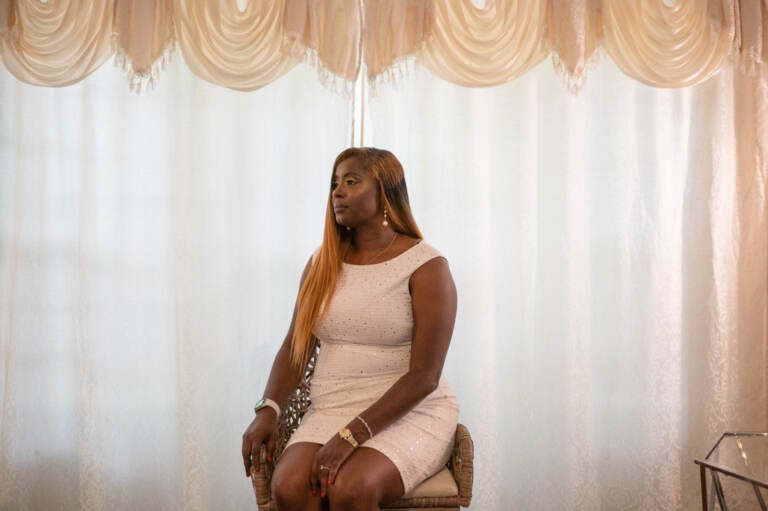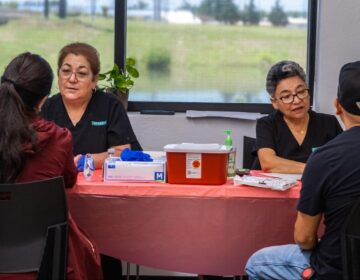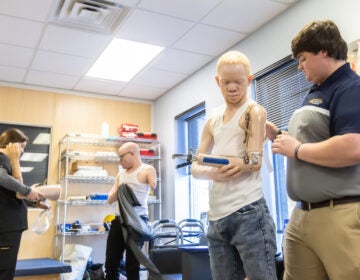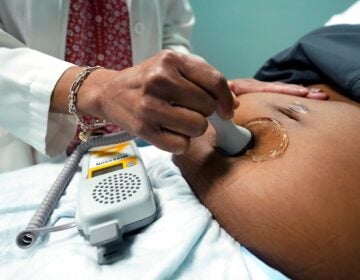A ‘staggering’ number of people couldn’t get care during the pandemic, poll finds

Tomeka Kimbrough-Hilson was diagnosed with uterine fibroids in 2006 and underwent surgery to remove a non-cancerous mass. When she started experiencing symptoms again in 2020, she was unable to get an appointment with a gynecologist. Her experience was not uncommon, according to a new poll by NPR, the Robert Wood Johnson Foundation and the Harvard T.H. Chan School of Public Health. (Nicole Buchanan for NPR)
When the pandemic started, Tomeka Kimbrough-Hilson knew she had a small growth inside her uterus. She was first diagnosed with uterine fibroids back in 2006 and had been able to have the non-cancerous mass removed through outpatient laser surgery. Over the years, she’d also been able to manage her symptoms with medication and changes in her lifestyle.
But when those symptoms – a bloated belly, irregular periods, nausea – returned in 2020, Kimbrough-Hilson was unable to get an appointment with a specialist.
“March 27th came and everything got shut down,” says Kimbrough-Hilson, 47, of Stone Mountain, Georgia. “I wasn’t at the tier of care that needed [immediate attention], because of all the precautions that had to be taken.”
But even after the lockdown in spring of 2020 was lifted, Kimbrough-Hilson, a mother of five who works in the health insurance industry, was unable to see a gynecologist.
She left message after message with providers. But her calls went unreturned, or providers were booked for months at end. “I couldn’t get the appointments,” she says. “I couldn’t follow up.”
These days, her belly is swollen, and she says she often feels fatigued and nauseous: “It makes me want to throw up a lot.”
She also struggled to get appointments for other members of her family. Her 14-year-old daughter underwent brain surgery before the pandemic, but then couldn’t get follow-up appointments until recently.
Kimbrough-Hilson’s family’s experience isn’t uncommon, according to a new poll by NPR, the Robert Wood Johnson Foundation and the Harvard T.H. Chan School of Public Health.
Among households that had a serious illness in the past year, one in five respondents said they had trouble accessing care during the pandemic.
That’s a “staggering” number of people unable to access care, says Mary Findling, the assistant director of the Harvard Opinion Research Program. “From a health and a good care standpoint, that’s just too high.”
Other recent studies have found significant delays in cancer screenings, and disruptions in routine diabetes, pediatric and mental health care. While it’s still early to know the long-term impacts on people’s health, researchers and physicians are concerned, especially as the disruptions continue with the country’s health care system struggling to bounce back from the pandemic.
The new poll also found that disruptions in care hit some racial and ethnic groups harder. Among households where anyone had been seriously ill in the past year, 35% of American Indian and Alaska Native households and 24% of Black households had trouble accessing care for serious illness, compared with only 18% of White households.
Among Black respondents who had seen a provider in the past year, 15% said they were disrespected, turned away, unfairly treated, or received poor treatment because of their race and ethnicity, compared with only 3% of White respondents who said the same.
“What’s really sad is the racial gaps in health care between Black and White Americans has remained,” says Findling. “And looking across a broad range of measures, it’s better to be a White patient than a Black patient in America today. And when you just stop and think about that, that’s horrible.”
Health insurance wasn’t a barrier to access
The vast majority of people – across racial and ethnic groups – who experienced delays in care reported having health insurance.
“One thing it tells us is that just the provision of more health care insurance is not going to plug some of these gaps and holes that we’re seeing in terms of individuals getting more care,” says Loren Saulsberry, a health policy researcher at the University of Chicago, who worked closely with Findling on the poll.
“There are broader issues at play here,” says Findling, like the historic workforce shortages among health systems. “The pandemic continues and it’s wreaking havoc on everyone.”
Saulsberry, who studies health disparities in vulnerable populations, says that the pandemic has exacerbated those disparities because of a range of barriers, including a person’s zip code.
For example, the state of Georgia, where Kimbrough-Hilson lives, has had one of the lowest numbers of OB-GYNs in the country for years. Now, she’s having a harder time getting an appointment with one than ever before.
“I’ve been able to get my teeth done, my eyes checked,” she says. “But I can’t get to women’s health.”
She has a referral from her primary care provider, she says, but it’s for a practice “30 to 40 miles away.”
Health systems too overwhelmed for routine care
While the pandemic exacerbated disparities in care, it also overwhelmed the health care system, causing delays and disruptions across the board, says Cassie Sauer, CEO of the Washington State Hospital Association.
And it’s also taken a huge financial toll, says Dr. Arif Kamal, chief patient officer at the American Cancer Society. “Some of that is related to actually taking care of patients who are very complex, who have very serious illnesses due to COVID-19,” he says. “But also during that time there was also loss of revenue because other activities had to be stopped, for example, elective surgeries.”
As a result, preventive services and early detection activities – not the “highest margin activities” for health systems – have taken a back seat, he adds.
“Over the last two years we estimate about 6 million women, for example, have missed routine cancer screening,” says Kamal. That includes missed mammograms for breast cancer detection, and Pap smears to check for cervical cancer.
Kamal is concerned that in a year or two, providers will start to detect cancers at later stages because of missed screenings, which makes them harder to treat or cure.
In the meantime, health systems are continuing to feel the repercussions of the pandemic, causing continuing delays in what was once routine care.
Sauer has experienced this at work and in her personal life.
“In my own family, we have struggled to get access to health care for my kids and my parents,” says Sauer.
Her 80-year-old father, who has Parkinson’s disease, had a fall over the winter holidays and was hospitalized. “I was with him, caring for him in the hospital. My mom had COVID at the time, so she wasn’t able to be there,” she says. “And I couldn’t figure out how to get him out of the hospital.”
He needed to go to a skilled nursing facility, but she couldn’t get him into one. “I found two nursing homes that seemed like good fits,” says Sauer. “And they both shut down because they had COVID outbreaks the same day.”
This is still one of the biggest problems that the state’s hospitals are facing right now, she adds. “We can’t get people out of the hospitals right now. There’s no back door, but the front door is wide open to the emergency room.”
There are patients who spend as many as 90 days in a hospital, she says, when the average hospital stay is three days. “So they’ve taken the space of 30 patients who needed care.”
This is why, more than two years into the pandemic, she says, people are still unable to schedule regular procedures, everything from knee and heart valve replacements, to cancer treatments.
These procedures may be considered “elective,” but postponing them can have major repercussions on a patient’s health and quality of life, she adds.
“You have a chance of falling, you are probably going to gain weight,” says Sauer. “You’re going to lose flexibility. You know, all those things contribute to a potential decline, cardiac issues, respiratory issues.” Which can in turn also increase someone’ risk of serious illness from COVID.
“I think that the toll of this delayed care is tremendous,” she says.
9(MDAzMzI1ODY3MDEyMzkzOTE3NjIxNDg3MQ001))




